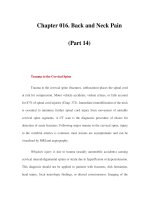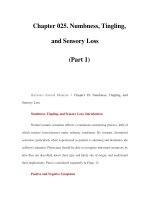Chapter 094. Soft Tissue and Bone Sarcomas and Bone Metastases (Part 4) ppsx
Bạn đang xem bản rút gọn của tài liệu. Xem và tải ngay bản đầy đủ của tài liệu tại đây (43.93 KB, 5 trang )
Chapter 094. Soft Tissue and Bone Sarcomas
and Bone Metastases
(Part 4)
Bone Sarcomas
Incidence and Epidemiology
Bone sarcomas are rarer than soft tissue sarcomas; they accounted for only
0.2% of all new malignancies and 2370 new cases in the United States in 2007.
Several benign bone lesions have the potential for malignant transformation.
Enchondromas and osteochondromas can transform into chondrosarcoma; fibrous
dysplasia, bone infarcts, and Paget's disease of bone can transform into either
malignant fibrous histiocytoma or osteosarcoma.
Classification
Benign Tumors
The common benign bone tumors include enchondroma, osteochondroma,
chondroblastoma, and chondromyxoid fibroma, of cartilage origin; osteoid
osteoma and osteoblastoma, of bone origin; fibroma and desmoplastic fibroma, of
fibrous tissue origin; hemangioma, of vascular origin; and giant cell tumor, of
unknown origin.
Malignant Tumors
The most common malignant tumors of bone are plasma cell tumors (Chap.
106). The four most common malignant nonhematopoietic bone tumors are
osteosarcoma, chondrosarcoma, Ewing's sarcoma, and malignant fibrous
histiocytoma. Rare malignant tumors include chordoma (of notochordal origin),
malignant giant cell tumor and adamantinoma (of unknown origin), and
hemangioendothelioma (of vascular origin).
Musculoskeletal Tumor Society Staging System
Sarcomas of bone are staged according to the Musculoskeletal Tumor
Society staging system based on grade and compartmental localization. A Roman
numeral reflects the tumor grade: stage I is low-grade, stage II is high-grade, and
stage III includes tumors of any grade that have lymph node or distant metastases.
In addition, the tumor is given a letter reflecting its compartmental localization.
Tumors designated A are intracompartmental (i.e., confined to the same soft tissue
compartment as the initial tumor), and tumors designated B are
extracompartmental (i.e., extending into the adjacent soft tissue compartment or
into bone). The tumor node metastasis (TNM) staging system is shown in Table
94-2.
Table 94-2 Staging System for Bone Sarcomas
Primary tumor
(T)
TX Primary tumor cannot be assessed
T0 No evidence of primary tumor
T1 Tumor ≤8 cm in greatest dimension
T2 Tumor >8 cm in greatest dimension
T3 Discontinuous tumors
in the primary
bone site
Regional lymph
nodes (N)
NX
Regional lymph nodes cannot be
assessed
N0 No regional lymph node metastasis
N1 Regional lymph node metastasis
Distant
metastasis (M)
MX
Distant metastasis cannot be assessed
M0 No distant metastasis
M1 Distant metastasis
M1a
Lung
M1b
Other distant sites
Histologic grade
(G)
GX Grade cannot be assessed
G1 Well differentiated—low grade
G2 Moderately differentiated—low grade
G3 Poorly differentiated—high grade
G4 Undifferentiated—
high grade
(Ewing's is always classed G4)









